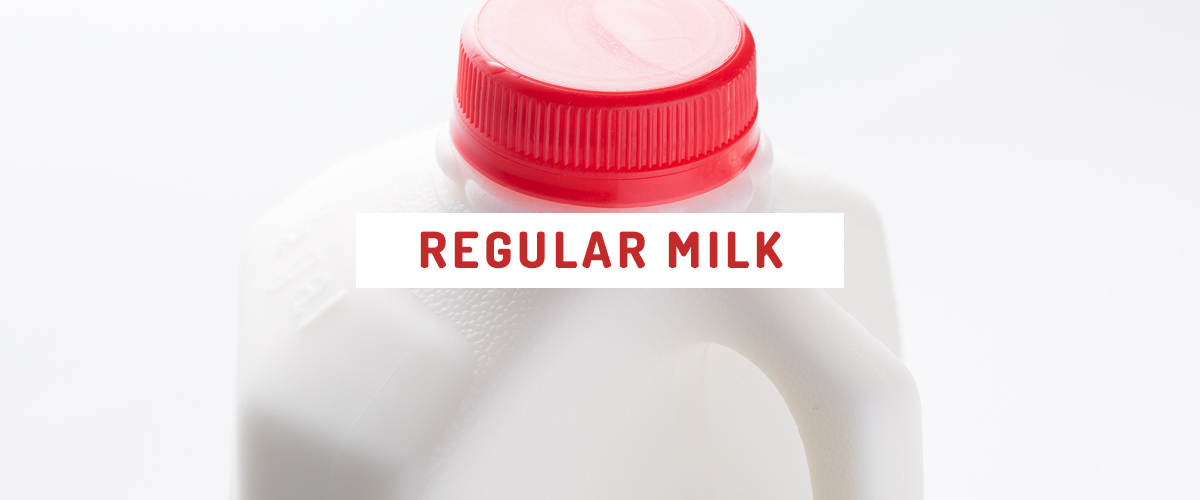The idea that “milk does a body good” has been hammered into our heads since we were children. Running with scissors is a bad idea, carrots make you see better, milk makes you strong—those were just the rules.
And while research only continues to prove the nutritional value of milk [1], new light is being shed on the added benefits that come specifically with drinking organic varieties.
It might make sense that a less processed version would be even more beneficial. As we know is the case with fruits and vegetables, keeping food products in as much of a natural state as possible ensures the full nutritional profile.
Calling it organic also takes it to a whole other level. The word alone automatically paints a healthier picture [2]. Seeing it printed next to a menu item or on food packaging, the assumption is that the organic option is inherently a better choice [3]. So, why do both exist and which one is really the best option for your cereal, smoothies, and the all important milk mustache?
How all milk is made
Let’s start right at the source. Both regular and organic milk originate from dairy farms where cows are milked two to three times per day. To maintain production, the herd generally spends eight hours grazing and is routinely fed after each milking, which is the main sticking point between organic and regular milk [4].
Organic milk means the animals that produced it were fed natural grasses and vegetation, as opposed to the more traditional corn and grain diets that have become standard feed [5]. Since we are what we eat, the food supply source of dairy cows becomes very important for our own nutrition.
Regular milk
Besides the feed of dairy cows, there are other important differences in how regular and organic milk is made.
In traditional procedures, milk is stored in temperature-controlled vats or silos for no longer than 48 hours [6]. (Constant refrigeration during this stage prevents the milk fat from separating.) The milk is then transported to a processing facility where it can be pasteurized and homogenized; here it is also inspected for quality and nutritional value.
Pasteurization
Pasteurization is meant to destroy harmful bacteria and ensure the quality of milk by preventing it from spoiling. During the pasteurization process whole milk is heated at various temperatures for different amounts of time in order to kill bacteria, and then is cooled to preserve the taste [7].
Homogenization
Homogenization comes next and is essentially a fancy mixing process. The goal is to achieve a consistent texture and ensure that fat is dispersed evenly. To do this, raw milk is forced through an atomizer that breaks the fat into tiny particles that can be more easily distributed [8].
Types of regular milk
There are different types of regular milk sold in grocery stores, all referring to varying fat contents. While all are essentially sourced in the same manner listed above, there are some small modifications made to control the overall milk fat makeup [9].
- Whole milk: Whole milk contains 3.25% to 3.50% milk fat and is the closest to the unprocessed state, which also makes it the nearest relative to organic milk.
- 1% and 2% milk: Percentages simply indicate the amount of milk fat present by weight. This is varied by completely removing all of the fat from milk before adding a specified amount back into the liquid. Two percent is also called “reduced fat milk” and one percent is referred to as “low fat milk.” Oftentimes, these kinds are the most popular and thought to be a better balance of fats and nutritional value.
- Skim milk: Finally, skim milk is what whole milk with all of the fat removed.
Nutrition facts and health benefits of regular milk
Regular milk provides a great deal of essential vitamins and nutrients for development and growth, especially in children, and can also help keep the body in proper working order at any age. It’s packed with:
- Vitamin D, a potent vitamin most often sourced from the sun that helps with energy levels, digestive health, immune system defense, and various skin conditions [10].
- Protein, an important building block of bones, muscles, cartilage, skin, and blood. Protein is essential to making enzymes, hormones, and other important body chemicals [11].
- Magnesium, a big help in migraine headaches, insomnia, and depression [12,13,14].
- Calcium, which keeps bones and teeth strong but also plays a vital role in muscle contraction, transmitting messages through the nerves, and the release of hormones [15].
- Potassium, which plays an integral role in regulating blood pressure and heart rhythm. Plus, studies show that people who consume diets high in this mineral tend to be at a lower risk of stroke, osteoporosis, and renal disease [16].
- Vitamin B12, which helps with proper red blood cell formation, regular body function, and energy levels [17].
Organic milk
The title “organic milk” refers mostly to the food stock that dairy cows eat, which is free of pesticides and fertilizers. It also means lack of hormones and antibiotics administered to cows and a more humane treatment overall. But, the term organic also alludes to different processing.
UHT processing
Unlike regular milk, organic milk does not adhere to pasteurization [18]. Rather it’s treated with something called ultrahigh temperature (UHT), which flash heats the milk to 280 degrees Fahrenheit for mere seconds. Doing so at such a high temperature ensures all bacteria is killed off and allows milk to be stored at room temperature for up to six months (as opposed to a shelf time of less than a week with regular milk).
However, UHT treatment also sweetens the milk by burning (and therefore caramelizing) some of the inherent sugars. Some people may be turned off by the different taste and the lack of refrigeration, though this is a fairly normal practice in many parts of the world, including most of Europe.
Nutrition facts and additional benefits of organic milk
Though organic milk will have a very similar nutritional profile to regular milk (including stores of vitamin D, protein, magnesium, calcium, potassium, and vitamin B12), there are also some added benefits with this variety [19]. The biggest bonus appears to be related to the concentration of omega-3’s fatty acids, a super important nutrient that science discovered once helped the evolution of the human brain.
A recent study headed up by researchers at Washington State University observed nearly 400 samples of both regular milk and organic milk, which was very telling in the distribution of healthy fat content.
More Omega-3’s
The study found that organic milk yields 62% more omega-3’s than conventional varieties of milk, which have more omega-6’s. So, what’s the difference between the two?
Omega-3’s are the health-boosting fatty acids common in fish oil and plant sources. They have been shown to increase the effectiveness of anti-inflammation medication as well as help in the battle against ADHD, depression, asthma, and Alzheimer’s disease.
Omega-6’s are also important for the human diet, but are often consumed in excess since they are most commonly found in popular foods made with vegetable oils, soybean oils, corn oils, poultry and eggs. In fact, the typical American diet contains up to 25 times more omega-6’s than omega-3 fatty acids, but too much of the former can lead to weight issues, inflammation, and complex pain syndrome.
“Most scientists agree that excessive omega-6 intakes can cause problems and that omega-3 intakes are now lower than ideal in the typical American diet.” —Dr. Charles Benbrook, Washington State University
How else is organic milk different?
Recent research has also indicated that organic milk offers:
- 69% more alpha-linoleic acid, an essential fatty acid often found in seeds that helps keep the heart and blood vessels healthy. As such it has been known to prevent heart attacks, lower blood pressure and cholesterol, and even stave off cardiovascular disease.
- 41% more conjugated linoleic acid, a similar compound found in meat and dairy that has great effects on cancer, obesity, and in limiting food allergies.
Slightly higher levels of vitamin E and iron were also found in organic milk, but not enough to be perceived as beneficial since milk is not a main source of either.
Which is better: organic milk or regular milk?
While both milk choices have a very similar nutrient base, organic products often have less human handling and interaction and less chemicals and hormones, which makes for a healthier product overall. And people seem to be catching on, buying organic products in such high numbers that demand is at all all-time high.
The proof is also in the numbers for milk. Though Americans are now consuming less milk than ever before, organic milk sales are continuing the steady climb that has been seen for a number of years. Today, organic milk constitutes 4 percent of total milk consumption and is only continuing to grow. When given a choice, it seems many are making the switch.
Photo credit: Alicia Cho
This article is related to:
Comparison Shopping, Food, Health, Healthy Ingredients, Nutrition, OrganicDownload the app for easy shopping on the go
By providing your mobile number, you agree to receive marketing text messages from Thrive Market. Consent not a condition to purchase. Msg & data rates apply. Msg frequency varies. Reply HELP for help and STOP to cancel.
This site is protected by reCAPTCHA and the Google Privacy Policy and Terms of Service apply.

